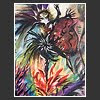


Plates: Top: plate 1, Hecate Rising, Middle: Plate 2, Resurrection, Bottom: Plate 3 Plaything. All images, Juliette Fretté, all rights reserved.
Looking critically at the paintings of Juliette Fretté, a position could be established that her work has much in common with primitivism, both as images and as philosophical examples of primitivist thought. Her background is as an art outsider, outside of matriculated academic experience, lending credence to the position Juliette Fretté is primitivist.
A greater number of self-taught artists have been defined as primitivist than the minority of degreed artists practicing primitivist artforms. At one time, Pablo Picasso was most likely the most well-known practitioner of primitivism, in summation; his academic experience began very young under the direction of his artist father. When Pablo was 13 he spectacularly entered the Barcelona Academy of Arts. While most students needed a month to study for the entrance exam, Picasso used a week. He blew the examining body away despite his adolescent age. Next, his father and uncle decided to send 16-year-old Pablo to the Madrid Academy "San Fernando", known later as the School of Art. Picasso's attendance lasted not a long time (less than one year). He never received a degree. Ten years later, one figure in Picasso's Les Demoiselles d'Avignon is a likeness of a primitivist African tribal mask, and Picasso ushered in the crossing over of primitivism to mainstream contemporary art with the advent of Les Demoiselles d'Avignon.
Images within the global vernacular of Juliette Fretté are consistent with forms enunciated by Picasso's primitivist period, generally attributed to Picasso during the period of 1907-1909. Figures resembling petroglyphs in plate 1, titled Hecate Rising demonstrate Fretté as a primtivist painter, if the painting imagery had been less densely composed and her pigments applied to a cave wall, the genre study would be complete. The figural forms in this painting have dimensions of tribal earmarking.
Next in Resurrection, at Plate 2, we find a highly consistent congruence in the compositional characteristics from the first painting to the next. To be more specific, Juliette Fretté has a strong uniformity of expression through her paintings, one of the prime reasons her work was chosen to be exhibited by Seattle-based curator and gallerist Paul Pauper in March 2010. But each work finds a highly original and distinctly unique method of conveying the visual information Juliette Fretté has chosen to communicate. In Resurrection, African primitivist influences and Indonesian indigenous styles are echoed.
Finally, the simplified symbolic, rune-like image of Plaything, at Plate 3, has reduced the primitivist aesthetic to the gestural sublimation of a Maori tattoo. From the selections exhibited here, Juliette Fretté displays the formal attributes of primitivism.
We have made the argument for establishing Juliette Fretté as a primitivist artist, her images contain the formal parameters circumscribing primitivism. Juliette Fretté's philosophical description posesses primitivist attributes as well. Juliette Fretté has established herself as a feminist columnist for the San Francisco Examiner. From this subjective position, she has espoused a tribal viewpoint, and by association, a primitivist viewpoint. The attribution is not hers, it must be clarified, but rather this essayist's opinion, that the tribal/primitivist connection might be hypothesized. Basques, Minangkabau, Mosuo, Berbers or Tuareg are examples of matriarchical or matrilocal tribal cultures. Strongly matrilocal societies sometimes are referred to as matrifocal, and there is some debate concerning the terminological delineation between matrifocality and matriarchy. Note that even in patriarchical systems of male-preference primogeniture there may occasionally be queens regnant, as in the case of Elizabeth I of England or Victoria of the United Kingdom. From this point of view, the theory is established for a philosophical primitivism on the part of Juliette Fretté.
